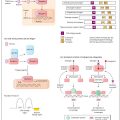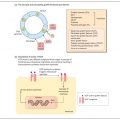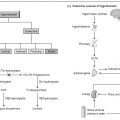
Short stature in children is a common presenting complaint. The majority of short children do not have an identifiable abnormality and thus it is important to make accurate measurements of height over a period of time and to calculate growth velocity. Short stature can reflect a wide range of underlying causes, ranging from nutritional and psychosocial factors, to endocrine disorders and genetic dysmorphic syndromes.
Growth hormone deficiency (GHD; Fig. 10a) has numerous causes related to congenital midline structural defects of the hypothalamus and pituitary, acquired lesions following perinatal trauma or central nervous system infections, primary and secondary tumours of the hypothalamus and pituitary, autoimmune hypophysitis and following cranial irradiation. In the majority of cases the cause is unknown (‘idiopathic’ GHD; Fig. 10b). Children with GHD present with growth failure and typical features relating to GH effects on bone and body composition. Thus the facial appearance is immature with a depressed central zone and prominent forehead related to lack of GH effects on skull maturation. GHD children have reduced muscle bulk and increased central fat deposition consistent with a lack of the metabolic effects of GH. Untreated they will reach approximately 65 to 70% of predicted adult height and this can be reversed by the introduction of GH replacement therapy at the earliest possible age (Fig. 10a).
Prenatal growth
Stay updated, free articles. Join our Telegram channel

Full access? Get Clinical Tree








